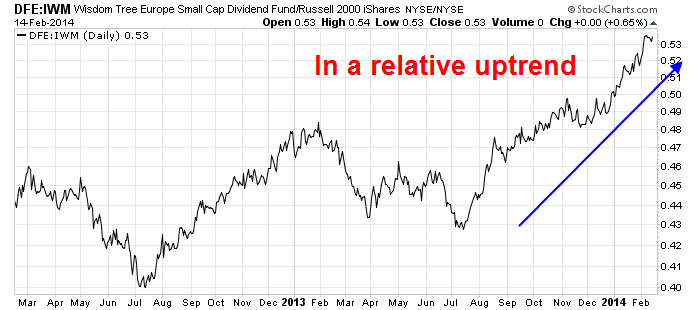I’ve been getting some emails and read a few articles recently about the strength in Europe. And sure, since the summer of 2012 (when the Eurozone was actually being called an “experiment”) European stocks have rallied very nicely. But when looking at a longer-term chart, it appears like just a counter-trend bounce.He based his analysis on the FEZ (Euro STOXX 50 ETF)/SPY pair:
FEZ vs. SPY
He went on to zoom into a closer look and indicated that the FEZ/SPY pair was still in a wedge. In other words, the jury is still out.
FEZ vs. SPY, A shorter time horizon
Here's my take on the situation. The latest reading of the eurozone's GDP growth shows that that region's growth rates continues to be encouraging:
FEZ consists of large cap eurozone stocks with global companies such as Total, Siemens and Daimler, which is more of a play on global growth and the competitiveness of European exporters. A better way to be exposed to European growth is DFE, which is the European small cap ETF, as small caps do more business in Europe and they are sensitive to the growth outlook in that region.
A look at the relative returns of DFE to IWM (European small caps to American small caps) clearly shows which region has the upper hand in relative strength, though DFE appears a bit extended against IWM.
In addition to DFE representing European small caps, it has one other key difference relative to FEZ. While FEZ represents just eurozone equities, a detailed examination of the structure of DFE has a significant weight in non-eurozone countries, such as the UK (25%) and Switzerland (9%).
To be sure, some strategists, like Ed Yardeni, have questioned the growth outlook of eurozone equities and that remains a risk for any investor in Europe:
On a relative strength basis, however, the momentum continues to favor European small caps and, by extension, the prospect for Europe's economic recovery.
My inner trader understands the risks raised by Yardeni, but also knows that these things sometimes don't matter to the market until they matter. So he is inclined to stay with the momentum trade, but maintain a tight risk control discipline to limit losses.
Cam Hui is a portfolio manager at Qwest Investment Fund Management Ltd. (“Qwest”). The opinions and any recommendations expressed in the blog are those of the author and do not reflect the opinions and recommendations of Qwest. Qwest reviews Mr. Hui’s blog to ensure it is connected with Mr. Hui’s obligation to deal fairly, honestly and in good faith with the blog’s readers.”
None of the information or opinions expressed in this blog constitutes a solicitation for the purchase or sale of any security or other instrument. Nothing in this blog constitutes investment advice and any recommendations that may be contained herein have not been based upon a consideration of the investment objectives, financial situation or particular needs of any specific recipient. Any purchase or sale activity in any securities or other instrument should be based upon your own analysis and conclusions. Past performance is not indicative of future results. Either Qwest or I may hold or control long or short positions in the securities or instruments mentioned.






1 comment:
Very nice analysis. I like your ratio analysis and it's the reason i come here.
Post a Comment